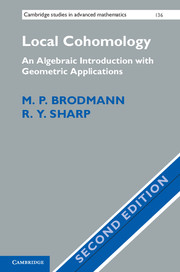Book contents
- Frontmatter
- Contents
- Preface to the First Edition
- Preface to the Second Edition
- Notation and conventions
- 1 The local cohomology functors
- 2 Torsion modules and ideal transforms
- 3 The Mayer–Vietoris sequence
- 4 Change of rings
- 5 Other approaches
- 6 Fundamental vanishing theorems
- 7 Artinian local cohomology modules
- 8 The Lichtenbaum–Hartshorne Theorem
- 9 The Annihilator and Finiteness Theorems
- 10 Matlis duality
- 11 Local duality
- 12 Canonical modules
- 13 Foundations in the graded case
- 14 Graded versions of basic theorems
- 15 Links with projective varieties
- 16 Castelnuovo regularity
- 17 Hilbert polynomials
- 18 Applications to reductions of ideals
- 19 Connectivity in algebraic varieties
- 20 Links with sheaf cohomology
- References
- Index
Notation and conventions
Published online by Cambridge University Press: 05 December 2012
- Frontmatter
- Contents
- Preface to the First Edition
- Preface to the Second Edition
- Notation and conventions
- 1 The local cohomology functors
- 2 Torsion modules and ideal transforms
- 3 The Mayer–Vietoris sequence
- 4 Change of rings
- 5 Other approaches
- 6 Fundamental vanishing theorems
- 7 Artinian local cohomology modules
- 8 The Lichtenbaum–Hartshorne Theorem
- 9 The Annihilator and Finiteness Theorems
- 10 Matlis duality
- 11 Local duality
- 12 Canonical modules
- 13 Foundations in the graded case
- 14 Graded versions of basic theorems
- 15 Links with projective varieties
- 16 Castelnuovo regularity
- 17 Hilbert polynomials
- 18 Applications to reductions of ideals
- 19 Connectivity in algebraic varieties
- 20 Links with sheaf cohomology
- References
- Index
Summary
All rings considered in this book will have identity elements.
Throughout the book, R will always denote a non-trivial commutative Noetherian ring, and a will denote an ideal of R. We shall only assume that R has additional properties (such as being local) when these are explicitly stated; however, the phrase ‘(R,m) is a local ring’ will mean that R is a commutative Noetherian quasi-local ring with unique maximal ideal m.
For an ideal c of R, we denote Supp(R/c) = {p ∈ Spec(R) : p ⊇ c} by Var(c), and refer to this as the variety of c.
By a multiplicatively closed subset of R, we shall mean a subset of R which is closed under multiplication and contains 1. It should be noted (and this comment is relevant for the final chapter) that, if S is a non-empty subset of R which is closed under multiplication, then, even if S does not contain 1, we can form the commutative ring S−1R and, for an R-module M, the S−1Rmodule S−1M. In fact, S−1R ≅ (S ∪ {1})−1R, and, in S−1R, the element sr/s, for r ∈ R and s ∈ S, is independent of the choice of such s; similar comments apply to S−1M.
The symbol ℤ will always denote the ring of integers; in addition, ℕ (respectively ℕ0) will always denote the set of positive (respectively non-negative) integers. The field of rational (respectively real, complex) numbers will be denoted by ℚ (respectively ℝ, ℂ).
- Type
- Chapter
- Information
- Local CohomologyAn Algebraic Introduction with Geometric Applications, pp. xxi - xxiiPublisher: Cambridge University PressPrint publication year: 2012



